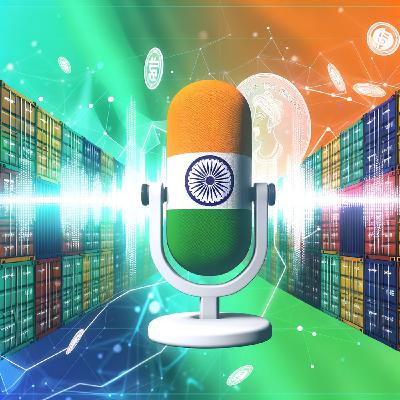US Slaps 50 Percent Tariffs on Indian Goods Amid Geopolitical Tensions Sparking Global Trade Reshuffling
Update: 2025-10-15
Description
Listeners, today’s spotlight is on India and the latest developments in US tariff policy under former President Donald Trump. As of October 2025, the US tariff on Indian goods stands at a steep 50 percent, the highest among America’s major trading partners. This dramatic rate resulted from two sequential hikes—first a 25 percent reciprocal tariff in August, followed by an additional 25 percent penal tariff aimed at sectors like textiles, gems, jewelry, leather, auto parts, and chemicals. The stated justification for these measures was geopolitical: India’s ongoing purchase of Russian oil and its leadership role in the BRICS alliance, both factors that the White House linked to national security and unfair trade practices as cited under US law.
According to ClearTax, these tariffs impact over 55 percent of India’s exports to the US, which make up nearly a fifth of India’s total overseas sales. Major export-linked industries have been hit hard. Apparel, which normally has a duty of 10 to 15 percent, now faces rates up to 60 percent. Gems and jewelry, a mainstay of India’s export engine, have seen duties soar from a mere 2 or 3 percent to over 50. The Confederation of Indian Textile Industry reports that one-third of its members have had their turnover slashed by more than half, with 85 percent facing excess inventory and two-thirds needing to offer steep discounts to buyers just to stay competitive.
The tariff regime includes exemptions for critical sectors like pharmaceuticals, electronics, energy, and certain minerals—these goods continue to move at zero US duty, protecting joint supply chains and the US market’s reliance on Indian generic drugs.
This policy shift has prompted intense diplomatic discussions. India has condemned the tariffs but is holding off on direct retaliation, focusing instead on support for small exporters, diversifying key markets, and taking the dispute to the World Trade Organization. India’s strategy is to refrain from escalation while safeguarding domestic industries and maintaining flexibility if talks stall.
Despite the tariff headwinds, India’s economy shows resilience. The International Monetary Fund, as reported by NDTV, just revised India’s 2025-26 growth forecast up to 6.6 percent, citing strong domestic momentum and reforms that offset the negative impact on exports. Goods exports overall grew 6 percent in September, even as US-bound shipments dropped sharply, according to newly released Commerce Ministry data.
Geopolitically, Trump’s trade war is seen as triggering a reorganization of global commerce. India and Brazil, both hammered by high tariffs, are deepening ties, searching for new markets, and driving the larger BRICS bloc into more assertive trading alliances. Bloomberg notes that US tariffs are pushing India and China to rethink relations, while industry observers warn the true cost may be a permanent shift in supply chains.
Listeners, thanks for tuning in. Don’t forget to subscribe for more real-time updates on India’s evolving trade landscape. This has been a quiet please production, for more check out quiet please dot ai.
For more check out https://www.quietperiodplease.com/
Avoid ths tariff fee's and check out these deals https://amzn.to/4iaM94Q
This content was created in partnership and with the help of Artificial Intelligence AI
According to ClearTax, these tariffs impact over 55 percent of India’s exports to the US, which make up nearly a fifth of India’s total overseas sales. Major export-linked industries have been hit hard. Apparel, which normally has a duty of 10 to 15 percent, now faces rates up to 60 percent. Gems and jewelry, a mainstay of India’s export engine, have seen duties soar from a mere 2 or 3 percent to over 50. The Confederation of Indian Textile Industry reports that one-third of its members have had their turnover slashed by more than half, with 85 percent facing excess inventory and two-thirds needing to offer steep discounts to buyers just to stay competitive.
The tariff regime includes exemptions for critical sectors like pharmaceuticals, electronics, energy, and certain minerals—these goods continue to move at zero US duty, protecting joint supply chains and the US market’s reliance on Indian generic drugs.
This policy shift has prompted intense diplomatic discussions. India has condemned the tariffs but is holding off on direct retaliation, focusing instead on support for small exporters, diversifying key markets, and taking the dispute to the World Trade Organization. India’s strategy is to refrain from escalation while safeguarding domestic industries and maintaining flexibility if talks stall.
Despite the tariff headwinds, India’s economy shows resilience. The International Monetary Fund, as reported by NDTV, just revised India’s 2025-26 growth forecast up to 6.6 percent, citing strong domestic momentum and reforms that offset the negative impact on exports. Goods exports overall grew 6 percent in September, even as US-bound shipments dropped sharply, according to newly released Commerce Ministry data.
Geopolitically, Trump’s trade war is seen as triggering a reorganization of global commerce. India and Brazil, both hammered by high tariffs, are deepening ties, searching for new markets, and driving the larger BRICS bloc into more assertive trading alliances. Bloomberg notes that US tariffs are pushing India and China to rethink relations, while industry observers warn the true cost may be a permanent shift in supply chains.
Listeners, thanks for tuning in. Don’t forget to subscribe for more real-time updates on India’s evolving trade landscape. This has been a quiet please production, for more check out quiet please dot ai.
For more check out https://www.quietperiodplease.com/
Avoid ths tariff fee's and check out these deals https://amzn.to/4iaM94Q
This content was created in partnership and with the help of Artificial Intelligence AI
Comments
In Channel





